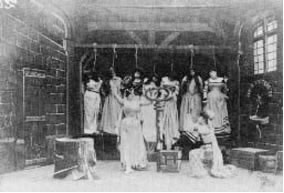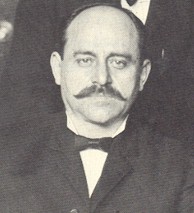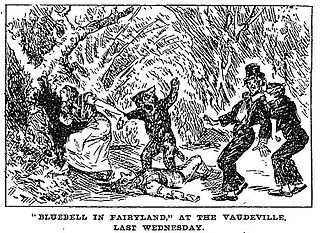Related Research Articles

"Bluebeard" is a French folktale, the most famous surviving version of which was written by Charles Perrault and first published by Barbin in Paris in 1697 in Histoires ou contes du temps passé. The tale tells the story of a wealthy man in the habit of murdering his wives and the attempts of the present one to avoid the fate of her predecessors. "The White Dove", "The Robber Bridegroom" and "Fitcher's Bird" are tales similar to "Bluebeard". The notoriety of the tale is such that Merriam-Webster gives the word "Bluebeard" the definition of "a man who marries and kills one wife after another". The verb "bluebearding" has even appeared as a way to describe the crime of either killing a series of women, or seducing and abandoning a series of women.

Barbe-bleue is an opéra bouffe, or operetta, in three acts by Jacques Offenbach to a French libretto by Henri Meilhac and Ludovic Halévy based on Charles Perrault's 1697 story.

Bluebeard is a 1944 film noir directed by Edgar G. Ulmer, starring John Carradine in the title role. The film also stars Jean Parker. The film is based on the famous French tale Barbe bleue that tells the story of a violent nobleman in the habit of murdering his wives and the attempts of one wife to avoid the fate of her predecessors. The film is registered in the public domain.

The Brides in the Bath is a 2003 television film by Yorkshire Television for ITV, based on the life and trial of British serial killer and bigamist George Joseph Smith, the "Brides in the Bath Murderer". Martin Kemp plays the role of Smith, and Richard Griffiths plays barrister Sir Edward Marshall-Hall. The film was directed by Harry Bradbeer, and written by Glenn Chandler.

Blue Beard is a 1901 French silent film by Georges Méliès, based on Charles Perrault's fairy tale "Bluebeard".

Johann Otto Hoch is the most famous and last-used alias of a German-born murderer and bigamist, John Schmidt. He was found guilty of the murder of one wife but is thought to have killed more, perhaps up to 50 victims. He was hanged.

R v Williams (1913) 8 Cr App R 133 was a 1912 murder in England that took its name from the hood the defendant, John Williams, wore when travelling to and from court. After the murder of a police inspector in Eastbourne, with no witnesses and little forensic evidence, Edgar Power, a former medical student, told the police that his friend John Williams had committed the murder. Power helped the police conduct a sting operation to catch Williams; police also interrogated Williams's girlfriend Florence Seymour, who then confessed to having helped Williams hide the murder weapon.
The Crumbles Murders are two separate and unrelated crimes which occurred on a shingle beach located between Eastbourne and Pevensey Bay, England—locally referred to as "the Crumbles"—in the 1920s. The first of these two murders is the 1920 bludgeoning murder of 17-year-old Irene Munro, committed by two men: Jack Field and William Gray. The second murder to occur upon the Crumbles is the 1924 murder of 38-year-old Emily Kaye, who was murdered by her lover, Patrick Mahon.

Fryniwyd Tennyson Jesse Harwood was an English criminologist, journalist and author.

Bluebell in Fairyland is a Christmas-season children's entertainment described as "a musical dream play", in two acts, with a book by Seymour Hicks, lyrics by Aubrey Hopwood and Charles H. Taylor, and music by Walter Slaughter. It was produced by Charles Frohman. The creators sought to distinguish the work from a Christmas pantomime. The story concerns a flower girl, Bluebell, who on Christmas Eve goes to fairyland in search of the "Sleeping King", seeking to restore him to his throne, which has been usurped by the "Reigning King".

Peter Britton Tobin was a Scottish convicted serial killer and sex offender who served a whole life order at HM Prison Edinburgh for three murders committed between 1991 and 2006. Police also investigated Tobin over the deaths and disappearances of other young women and girls.

Bluebeard's Ten Honeymoons is a 1960 British thriller film directed by W. Lee Wilder and starring George Sanders, Corinne Calvet, and Jean Kent. The story is loosely based on that of the real-life serial killer Henri Désiré Landru.

Robert Nixon was an American serial killer, born in the small town of Tallulah, Louisiana, who confessed to five murders and multiple assaults, including the Los Angeles "brick bat murders" of 1937. Depicted with racist imagery in the mainstream press after his arrest, he was given the nickname the "Brick Moron" as he killed his victims with bricks and was depicted as dimwitted.

Harry F. Powers was a Dutch-born American serial killer who was hanged in Moundsville, West Virginia.

The Babes in the Wood Murders is a name that was used in the media to refer to a child murder case in which the bodies of three girls were found in Pennsylvania woodland.

Freddie Roscoe is a fictional character from the British Channel 4 soap opera, Hollyoaks. He is played by Charlie Clapham, and made his first screen appearance on 6 May 2013. Freddie's notable storylines have including learning Darren Osborne is his half-brother; murdering his stepfather Fraser Black, his affair with and eventual marriage to his brother Joe Roscoe's fiancée Lindsey Butterfield, his relationships with Mercedes McQueen and Sinead O'Connor, his feud with Joe, being framed for the fake murder of Mercedes by Grace Black, nearly being murdered by Lindsey, his on/off relationships with Marnie and Ellie Nightingale, having a daughter named Lexi Roscoe with Lindsey and allowing Joe and Mercedes to adopt Lexi.
Alfred Leonard Cline, known as The Buttermilk Bluebeard, was an alleged American serial killer responsible for murdering at least nine people.
Helmuth Schmidt, also known as The American Bluebeard, was a German-born American bigamist, murderer and suspected serial killer. Soon following his arrest in connection with the murder of maid Augusta Steinbach, Schmidt committed suicide in his jail cell. After searching through his properties, he was connected to the murders of three more women, with additional located jewelry and watches indicating possible other victims in New York and Missouri.
Alexey Vladimirovich Gromov, known as The Bluebeard, is a Russian serial killer who killed three common-law wives and one of their mothers between 2006 and 2011, after being released for a previous murder in 1994 for which he served 10 years. For his later killings, Gromov was found guilty and sentenced to life imprisonment.

Mathias Kindlinger, known as The Bluebeard of Schrems, was an Austrian murderer and suspected serial killer who was convicted of killing his first and fifth wives in 1927 and 1961, respectively, but is alleged to have been responsible for the deaths of three other women as well. He was never charged in the other murders and was instead sentenced to life imprisonment for the final murder, dying behind bars in 1964.
References
- 1 2 3 4 5 "Kills Family and Sets House Afire". The Washington Herald . 20 August 1912.
- 1 2 3 4 5 "Tragedy Reveals Modern Bluebeard Who Had Murdered Seven Wives, Page 1". The Evening Times. 11 September 1912.
- 1 2 "Alleged Bluebeard". Alexandria Gazette. 9 September 1912.
- 1 2 3 4 5 "Tragedy Reveals Modern Bluebeard Who Murdered Seven Wives, Part 2". The Evening Times. 11 September 1912.
- 1 2 "Second Wife Tells Story of Tragedy". The Bridgeport Evening Farmer. 18 September 1912.
- ↑ "England's Latest Bluebeard Has Been Captured and Identified, Part 1". The Evening Times. 12 September 1912.
- 1 2 "England's Latest Bluebeard Captured and Identified, Part 2". The Evening Times. 11 September 1912.